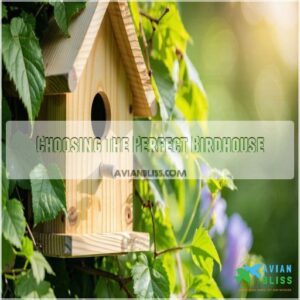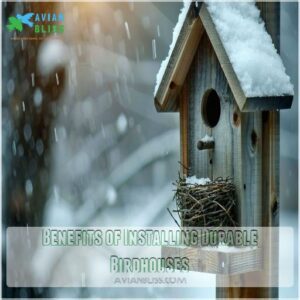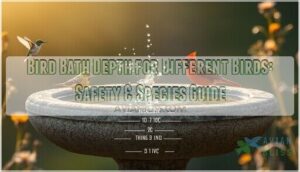This site is supported by our readers. We may earn a commission, at no cost to you, if you purchase through links.

Your feathered neighbors need proper ventilation, drainage holes, and an entrance sized for local species.
Mount the house 5-30 feet high, facing away from prevailing winds and afternoon sun.
Top picks include the Woodlink Bluebird House and Audubon Coppertop, both featuring easy-clean designs and predator protection.
Keep feeders nearby but not too close, and clean annually with diluted bleach.
Smart placement and regular maintenance will transform your backyard into a thriving bird sanctuary where generations of birds return to nest.
Table Of Contents
- Key Takeaways
- Choosing The Perfect Birdhouse
- Benefits of Installing Durable Birdhouses
- Factors to Consider When Selecting Birdhouses
- Top 7 Durable Bird Houses for All Weather
- Tips for Installing and Maintaining Durable Birdhouses
- Frequently Asked Questions (FAQs)
- What kind of birdhouses will birds actually use?
- Do birds stay in birdhouses in the winter?
- How do you weatherproof a birdhouse?
- Do you clean out bird houses every year?
- What paint colors attract different bird species?
- How often should birdhouses be relocated?
- Can multiple birdhouses be placed close together?
- Are solar-powered birdhouse features worth the investment?
- When is the best time to replace birdhouses?
- Conclusion
Key Takeaways
- You’ll get the best protection using cedar wood for your birdhouse, as it naturally resists decay and insects while providing proper insulation.
- Your birdhouse needs specific features like drainage holes, ventilation gaps near the roof, and entrance holes sized for local species (1.5 inches for bluebirds, 1.125 inches for smaller birds).
- You should mount your birdhouse 5–30 feet high on a pole with predator guards, facing away from prevailing winds and afternoon sun.
- You’ll need to clean your birdhouse annually with diluted bleach, removing old nesting material and checking for damage during late fall or early winter.
Choosing The Perfect Birdhouse
You’ll need to match your birdhouse’s features to your local bird species, considering factors like entrance hole size and interior dimensions for the perfect fit.
A well-chosen birdhouse made from weather-resistant materials like cedar will protect your feathered visitors from predators and harsh weather.
while providing them with a cozy spot to raise their families.
Size and Space Considerations
Just as you wouldn’t squeeze into a tiny house, birds need the right-sized home for comfort.
Different bird species require specific house dimensions – bluebirds prefer boxes 5.5 inches square with 8-inch depth, while wrens need smaller 4×4-inch spaces.
Interior space affects ventilation and nesting success, so consider your target species before buying.
The perfect nest box depth guarantees predator protection while giving nestlings room to grow.
Material Selection for Durability
Now that you’ve got your dimensions sorted, let’s talk about what your birdhouse should be made of. Cedar naturally stands out as the gold standard for birdhouse materials, but you’ve got options: besides cedar, you can also consider bird house building materials like untreated pine, exterior-grade plywood, or reclaimed plywood for a more eco-friendly approach.
- Cedar: Nature’s weatherproof champion, resisting rot and insects
- Pine: Budget-friendly but needs treatment
- Metal: Perfect for harsh climates, with aluminum leading the pack
- Composite: Modern alternative that mimics wood’s benefits
Each material needs specific treatment to maximize its lifespan and maintain a safe haven for your feathered friends.
Design and Assembly for Easy Maintenance
Beyond material selection, smart design features make birdhouse maintenance a breeze.
Look for hinged roofs or side panels that swing open for quick cleaning.
You’ll want drainage holes in the base and small ventilation gaps near the roof to prevent moisture buildup.
Pre-drilled mounting holes and simple assembly instructions save time, while removable bottoms make seasonal cleanouts effortless.
These design elements help your feathered friends stay healthy year-round.
Benefits of Installing Durable Birdhouses
You’ll create a lasting impact on local wildlife when you install a weather-resistant birdhouse.
Offering native birds a secure place to build nests and raise their young.
Your backyard will transform into a thriving habitat that supports bird conservation.
Providing you with front-row access to observe these fascinating creatures throughout the seasons.
Providing Safe Nesting and Breeding Sites
Installing a durable birdhouse means giving local birds a chance at raising their families safely.
Using materials like cedar or redwood and designing with features such as proper entrance hole sizes, will further guarantee their well-being.
Your backyard sanctuary becomes their fortress against harsh weather, lurking predators, and urban development pressures.
A well-built house, properly placed and maintained, offers birds a reliable shelter where they can nest undisturbed.
With the right material and ventilation, you’re creating a cozy corner where birds can thrive through every season.
Supporting Bird Populations and Conservation Efforts
Your well-placed birdhouse contributes to essential conservation work right in your backyard. As urban development shrinks natural habitats, you’re creating safe spaces that help local bird populations thrive.
Here’s how your birdhouse makes a difference:
- Supports species recovery programs, especially for declining songbirds
- Creates data collection opportunities for citizen science projects
- Helps maintain genetic diversity in urban bird populations
- Provides year-round shelter during harsh weather conditions
Enhancing Birdwatching Opportunities and Aesthetic Appeal
A well-placed birdhouse transforms your backyard into a front-row seat for nature’s theater. Watch parent birds zip back and forth with nesting materials, feed their chicks, and teach fledglings to fly.
You can find a perfect weatherproof birdhouse that will withstand the elements and provide a safe haven for birds.
The right house design adds character to your garden while doubling as a perfect photography subject.
Position houses near windows or patios to create your own live nature show, complete with daily bird drama.
Factors to Consider When Selecting Birdhouses
Your choice of birdhouse will directly affect which feathered friends make a home in your backyard, as features like entry hole size and mounting height determine which species can safely nest there.
You’ll need to account for practical elements like weather resistance, predator protection, and proper ventilation to guarantee your backyard birds have a safe and comfortable shelter.
They’ll want to return year after year.
Entry Hole Size and Bird Species
Now that you understand the benefits, let’s focus on matching entry holes to your feathered friends.
Think of it as finding the perfect doorway – too small and they can’t get in, too large and you’ll attract unwanted guests.
Most cavity-nesting birds need specific dimensions to feel at home.
- Chickadees and wrens thrive with 1.125-inch openings
- Bluebirds need 1.5-inch holes for comfortable entry
- Screech owls require 3-inch openings
Predator Protection and Pole Mounting
Predators pose a serious threat to nesting birds, making proper mounting essential.
While tree mounting might seem natural, pole mounting with guards offers superior protection.
Here’s a quick comparison of mounting methods:
| Method | Protection Level | Installation Difficulty | Maintenance |
|---|---|---|---|
| Pole w/Guard | Excellent | Moderate | Easy |
| Tree Mount | Poor | Easy | Difficult |
| Wall Mount | Good | Easy | Moderate |
| Ground Level | Very Poor | Very Easy | Very Easy |
Remember to install predator guards below the house and avoid perches, which give predators an advantage.
Ventilation and Drainage for Healthy Nesting
While pole mounting keeps birds safe from predators, proper ventilation and drainage prevent moisture-related health issues.
Think of a birdhouse like a tiny cabin – it needs to breathe and stay dry.
To guarantee good airflow, consider adding birdhouse ventilation solutions that promote healthy nesting environments.
Here’s what makes a healthy nesting environment:
- Small gaps under the roof for air circulation
- Drainage holes in the floor corners
- Sloped roof design to shed water
- Natural wood materials that allow moisture escape
- Quarter-inch holes along upper sides for cross-ventilation
Top 7 Durable Bird Houses for All Weather
You’ll find the perfect weather-resistant home for your feathered friends in our carefully tested selection of durable birdhouses.
These birdhouses withstand rain, sun, and snow.
We’ve evaluated these seven options based on material quality, predator protection, and maintenance features.
To help you make the best choice for your backyard birds.
1. Woodlink Bluebird House Birdhouse Wooden Home
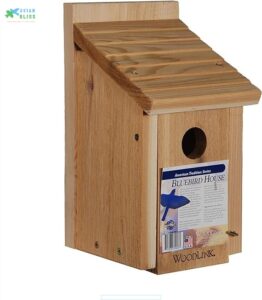
Woodlink’s cedar birdhouse combines thoughtful design with durability for bluebird enthusiasts. Its reforested, kiln-dried inland red cedar construction guarantees longevity, while the 1/2-inch entrance hole perfectly suits small native birds.
For those interested in purchasing this birdhouse, you can find it available at online retailers like Woodlink bluebird house products.
You’ll appreciate the practical features: a ventilation gap at the top prevents overheating, a drain hole manages moisture, and the front panel opens easily for cleaning.
Keep in mind that additional waterproofing might be needed, and you’ll want to monitor for unwanted sparrow visitors.
Best to mount this 11.75-inch-tall house before mating season begins.
Best For: Bird enthusiasts seeking a durable, ornithologically-designed bluebird house made from sustainable materials.
- Durable construction from reforested, kiln-dried cedar.
- Easy-to-clean design with an opening front panel.
- Appropriately-sized entrance hole for bluebirds.
- May require additional waterproofing.
- Not sparrow-resistant; requires monitoring and maintenance.
- Some users report difficulty attaching the door.
2. Rustic Cedar Bluebird Bird House
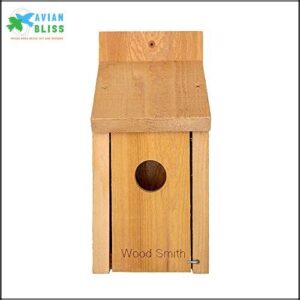
The Rustic Cedar Bluebird Bird House stands up to Mother Nature’s toughest challenges.
Built in Florida using locally sourced cedar, this 17-inch house features a 1.5-inch entrance hole perfect for bluebirds, finches, and chickadees.
You’ll appreciate the easy-clean door and built-in ventilation that keeps your feathered friends comfortable year-round.
The weather-resistant design includes mounting hardware and weatherproof screws, while professional construction guarantees lasting durability.
Customer reviews praise its sturdy build, though some mention occasional wood splitting during installation – nothing a careful setup can’t prevent.
Best For: Bird lovers seeking a durable, attractive, and easy-to-clean birdhouse for attracting bluebirds, finches, wrens, chickadees, and small woodpeckers.
- Durable construction from natural cedar wood.
- Easy-open door for convenient cleaning and maintenance.
- Includes all necessary mounting hardware and weatherproof screws.
- Minor wood splitting has been reported by some customers.
- Bird attraction may vary depending on placement.
- May require additional support for secure mounting on some surfaces.
3. Colorful Birdhouse Bird Feeder Garden Gift

One standout feature of this colorful birdhouse is its dual functionality as both a nesting spot and feeder.
You’ll appreciate the thoughtful design, including a metal screen bottom for ventilation and a sliding door that makes cleaning a breeze.
While the wood construction is relatively thin at 1/4 inch, users report it’s surprisingly sturdy.
Consider replacing the magnetic door closure with screws for added security, and you might want to remove the perch to deter predators. Birds typically move in within days, making this affordable option a cheerful addition to any garden.
Best For: Bird lovers seeking an affordable, attractive, and easy-to-clean birdhouse feeder.
- Attracts birds quickly.
- Easy to clean thanks to the sliding door.
- Colorful and aesthetically pleasing design.
- Weak magnet on the door may pose a safety hazard.
- Thin wood construction might not be very durable.
- Perch under the hole could attract predators.
4. Perky Pet Wren Birdhouse Home
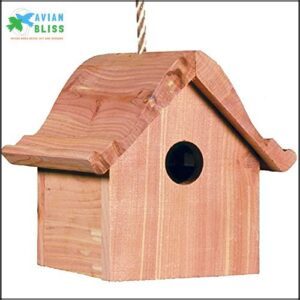
A sturdy cedar construction makes the Perky Pet Wren Home stand out for durability and natural appeal.
At 6.5 inches tall with a 1.5-inch entry hole, it’s perfectly sized for wrens, finches, and chickadees.
The Dutch-style roof design keeps rain at bay, while the hanging rope makes installation a breeze.
Users praise its easy-clean features and attractive white finish, though some note the construction could be sturdier.
Despite minor drawbacks, this affordable option delivers good value, especially if you’re looking to attract smaller songbirds to your backyard.
Best For: Attracting wrens, finches, and other small songbirds to your backyard.
- Durable cedar construction
- Easy to clean
- Attractive design
- Some reports of rickety construction
- Entry hole may be larger than expected for some species
- Appearance may differ slightly from online images
5. Audubon Coppertop Bluebird House

Made from natural cedar, this handcrafted Audubon Coppertop Bluebird House lets you provide a cozy shelter for local birds.
Its front-opening design makes cleaning a breeze, while the 1-9/16" entrance hole with predator guard keeps unwanted visitors out.
You’ll appreciate the generous interior dimensions of 4×4 inches, perfect for nesting pairs.
The white finish and copper roof add a touch of style to your yard, and mounting is simple with included screws.
Just remember to clean between broods and consider adding mealworms to attract more feathered friends. Audubon Coppertop Bluebird House is a great choice for bird lovers.
Best For: Bird lovers looking to attract bluebirds and tree swallows to their yard.
- High-quality, handcrafted construction.
- Easy-to-clean front-opening design.
- Effective predator guard.
- Reports of copper roof dents and poor fit.
- Some customers received missing parts.
- Front-opening design may limit monitoring.
6. Starling Resistant Birdhouse Entrance Holes
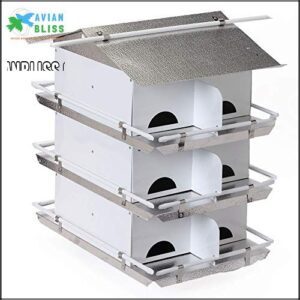
Birds Choice’s innovative PMSR12 birdhouse features Starling Resistant Entrance Holes that are 99.8% effective at keeping unwanted visitors out while welcoming Purple Martins.
You’ll appreciate the three-floor, twelve-room design with hinged doors for easy cleaning.
Built in Wisconsin from durable aluminum, it includes thoughtful features like porch dividers, a reflective roof, and guard rails.
While assembly takes a few hours, the result is worth it – you’re getting premium protection comparable to Coates Original Houses.
Just remember to remove it during severe weather seasons.
Best For: Those seeking a high-quality, durable Purple Martin house with excellent starling resistance and easy cleaning access.
- 99.8% effective starling-resistant entrance holes.
- Durable aluminum construction for long-lasting use.
- Easy cleaning thanks to hinged doors.
- Assembly can be time-consuming and require additional tools.
- Instructions may be unclear, potentially requiring extra effort.
- Shipping and customs charges may apply for international orders.
7. Build A Birdhouse Kit Toysmith
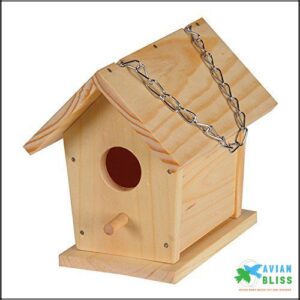
For DIY enthusiasts and families alike, the Toysmith Build A Birdhouse Kit offers a hands-on approach to backyard birding.
This classic wooden kit includes all essential parts, four paint colors, and a hanging cord.
While the included paint might need supplementing, the kit’s straightforward assembly makes it perfect for scout projects or family activities.
You’ll need to reinforce some pre-drilled holes with glue for extra stability.
Though compact at 6 inches tall, it’s ideal for smaller birds like chickadees and finches. Remember to grab a hammer – it’s not included.
Best For: Families and children aged 5+ looking for a fun and engaging craft project.
- Easy assembly (though adult supervision may be needed for younger children).
- Includes all necessary parts and materials (except a hammer).
- Provides a rewarding activity and a charming birdhouse.
- Included paint is of poor quality and insufficient.
- Some pre-drilled holes may be too large, requiring glue reinforcement.
- Birdhouse is smaller than expected by some.
Tips for Installing and Maintaining Durable Birdhouses
You’ll get the most out of your birdhouse by properly installing it and keeping up with simple maintenance tasks that protect your feathered friends.
A well-maintained birdhouse attracts more birds but also creates a safe, long-lasting home that can serve generations of nesting families through every season.
Placement Strategies for Optimal Bird Attraction
Once you’ve picked your perfect birdhouse, let’s get it set up right.
Mount it 5-30 feet high, depending on your target species, and face the entrance away from prevailing winds.
Keep feeders and water sources nearby, but not too close to prevent competition.
Planning for shade during hot afternoons helps, while strategic placement near native plants creates an irresistible habitat that’ll have birds flocking to your yard.
Regular Cleaning and Maintenance for Hygiene
Keeping your birdhouse spotless is like maintaining a tiny hotel – regular upkeep keeps your guests coming back.
Every fall, remove old nesting material and scrub the interior with a 10% bleach solution.
During breeding season, monthly checks help spot potential issues like loose screws or water damage.
Remember to wear gloves and a mask when cleaning, as old nests can harbor parasites.
Enhancing Bird-Friendly Landscaping for Biodiversity
Beyond regular birdhouse maintenance, creating a bird-friendly environment transforms your backyard into a thriving ecosystem.
Here’s how to make your space more inviting:
- Plant native trees and shrubs that provide natural shelter and food
- Install multiple water sources, from simple birdbaths to small fountains
- Set up diverse feeding stations with different seed types
- Create brush piles for ground-feeding birds
- Add pollinator gardens with nectar-rich flowers
These elements work together, supporting local bird populations while enhancing your backyard’s biodiversity.
Frequently Asked Questions (FAQs)
What kind of birdhouses will birds actually use?
Birds prefer natural wood houses with specific hole sizes – 5 inches for bluebirds, 125 for smaller species.
Choose cedar or cypress construction.
Add proper ventilation and drainage.
Mount on poles with predator guards.
Do birds stay in birdhouses in the winter?
Many songbirds will shelter in your birdhouse during winter storms and cold nights.
They’ll use it as a cozy refuge, especially if you’ve positioned it away from harsh winds and added some insulation.
How do you weatherproof a birdhouse?
To weatherproof your birdhouse, apply exterior-grade wood sealer to the roof and outer walls.
Drill drainage holes in the floor.
Add ventilation gaps near the roof.
Mount it slightly forward-facing to prevent rain seepage.
Do you clean out bird houses every year?
You’ll need to clean out birdhouses annually in late fall or early winter.
Remove old nesting material, sanitize with a mild bleach solution, and make certain proper drainage.
Prevent disease and maintain a healthy environment.
What paint colors attract different bird species?
Birds don’t actually care about paint colors – they’re drawn to natural wood tones.
If you must paint, stick to earth tones like browns and grays.
Bright colors can attract predators and aren’t recommended.
How often should birdhouses be relocated?
Relocating birdhouses isn’t necessary unless there’s poor nesting success.
If you’re not attracting desired species after two seasons, try moving the house to a different height or location with better protection.
Can multiple birdhouses be placed close together?
Keep birdhouses at least 20 feet apart to prevent territorial conflicts.
Different species can nest closer, but similar birds need more space.
Consider spacing them around your yard like a neighborhood development.
Are solar-powered birdhouse features worth the investment?
Solar-powered features like LED lights and cameras aren’t essential for bird survival.
While they’re fun for monitoring, you’ll get better value focusing on durability, proper ventilation, and predator protection in your birdhouse design.
When is the best time to replace birdhouses?
Replace your birdhouse during late fall or early winter.
when birds aren’t nesting.
This timing lets you inspect for damage, clean thoroughly, and make sure it’s ready for spring’s new residents.
Conclusion
Like a cozy mountain cabin that withstands nature’s fury, durable bird houses for all weather provide essential shelter for your feathered friends.
You’ll find success by choosing cedar construction, proper sizing, and smart mounting locations.
Remember to maintain your birdhouse regularly, keep predators at bay, and create an inviting habitat.
With these top picks and practical tips, you’re ready to transform your backyard into a vibrant sanctuary where birds will return year after year to raise their families.

